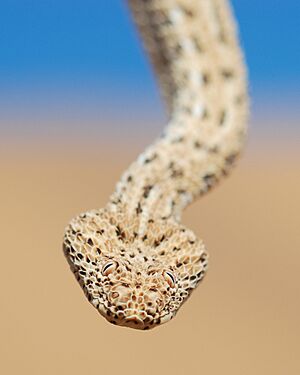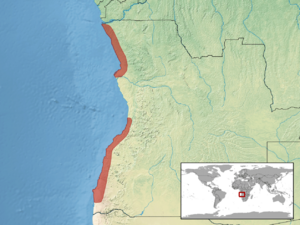Peringuey's adder facts for kids
Quick facts for kids Peringuey's adder |
|
|---|---|
 |
|
| Conservation status | |
| Scientific classification | |
| Genus: |
Bitis
|
| Species: |
peringueyi
|
 |
|
| Synonyms | |
|
|
Bitis peringueyi, also known as the Peringuey's adder, is a small, venomous viper species. You can find this snake in the deserts of Namibia and southern Angola. It's known for its unique way of moving and hunting in the sand. No different types (subspecies) of this snake are currently known.
Contents
What Does the Peringuey's Adder Look Like?
The Peringuey's adder is a small snake. It usually grows to be about 20 to 25 cm (8 to 10 in) long, including its tail. The longest one ever recorded was 32 cm (12.6 in).
Head and Body Features
Its head is short and flat, with its eyes located right on top. This helps it see when it's buried in the sand. The head is covered with bumpy scales.
The snake's body scales are also bumpy, except for the ones closest to its belly, which are smooth. It has 117 to 144 belly scales. The tail has 15 to 30 scales underneath, which are often bumpy too, especially near the tip.
Color and Pattern
The Peringuey's adder has colors that help it blend in with the sand. It can be pale buff, chestnut brown, orange-brown, or sandy-gray. It has three rows of faint, long, gray to dark spots along its body. The snake's body also has an uneven pattern of light and dark spots. Its belly is usually whitish or dirty yellow. The tail is generally tan, but about one-quarter of these snakes have a black tail.
Other Names for the Peringuey's Adder
People call Bitis peringueyi by many different names. Some of these include Peringuey's desert adder, sidewinding adder, Namib dwarf sand adder, dwarf puff adder, Namib desert sidewinding adder, dwarf sand adder, Namib dwarf adder, and Namib desert viper.
Where Did the Name Come From?
This adder was named after Louis Péringuey. He was a South African expert who studied insects and was also a museum director.
Where Do Peringuey's Adders Live?
You can find Bitis peringueyi in the Namib Desert. This desert stretches from southern Angola all the way down to Lüderitz, Namibia. They are also seen in the Fish River Canyon and often live near sand dunes. The first place this snake was officially found was near Walvis Bay in Namibia.
How Do Peringuey's Adders Behave?
The Peringuey's adder is an ambush hunter. This means it waits for its prey to come to it. It buries itself just under the sand, leaving only its eyes and the very tip of its tail showing. Its skull is shaped sharply, which helps it cut through the sand easily.
If a snake has a black tail tip, it might wiggle it to attract prey. This trick is called "caudal luring." When a small animal comes close, the snake quickly grabs it and bites it, injecting its venom.
What Do Peringuey's Adders Eat?
The Peringuey's adder eats different small animals. Its diet includes lizards like Meroles and the barking gecko Ptenopus. Lizards such as Aporosaura are very important for these snakes because they contain a lot of water, which helps the snakes stay hydrated in the dry desert.
Images for kids




